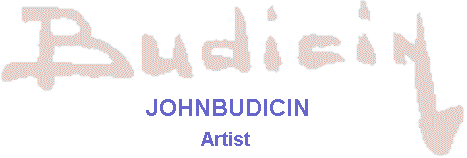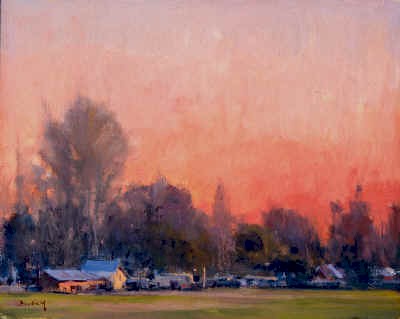 I
have always found painting outdoors to be exhilarating. Mother Nature is the
best teacher, and if you make a commitment to be out there day after day, she
will "speak" to you. During the painting process, many changes
take place before you. Perhaps a beam of light will illuminate a
particular area, or a cloud pattern will form. The foreground may go into
shadow, making the composition more dramatic. If you pay attention to
these changes and incorporate them into your work, it will be more interesting,
exciting and believable. I
have always found painting outdoors to be exhilarating. Mother Nature is the
best teacher, and if you make a commitment to be out there day after day, she
will "speak" to you. During the painting process, many changes
take place before you. Perhaps a beam of light will illuminate a
particular area, or a cloud pattern will form. The foreground may go into
shadow, making the composition more dramatic. If you pay attention to
these changes and incorporate them into your work, it will be more interesting,
exciting and believable.
Working small -- mostly 8" X 10" and 9" X 12",
but sometimes larger--gives me more time to observe (since I am not trying to
cover a large area with paint) and relate to the scene before me. I
particularly like late afternoon and evening light. To capture this, I
must work very quickly, before the fleeting light is gone.
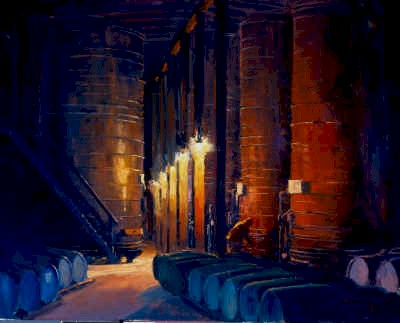 I'm
a firm believer in painting on the scene as opposed to using photographs.
I feel that photography can't take the place of time spent with your
subject--but it can serve a purpose. In my case, I may complete a field
study before the light changes too drastically, and then paint a larger version
of the scene back in the studio. That's where a photo can come in handy,
because it will include more detail. One quick brushstroke in a small
painting can become a large mass in a bigger one, so you need more information to fill it in.
I am careful
not to rely on the photo too much; for example, I don't want to be swayed by the color
in the photo. I turn to my study for color and value, and try to relive that scene
in my mind. I recall my emotions by closing my eyes for a few moments
and imagining myself there. Feeling the breeze, the sun, I try to
recapture my feelings at that time. I'm
a firm believer in painting on the scene as opposed to using photographs.
I feel that photography can't take the place of time spent with your
subject--but it can serve a purpose. In my case, I may complete a field
study before the light changes too drastically, and then paint a larger version
of the scene back in the studio. That's where a photo can come in handy,
because it will include more detail. One quick brushstroke in a small
painting can become a large mass in a bigger one, so you need more information to fill it in.
I am careful
not to rely on the photo too much; for example, I don't want to be swayed by the color
in the photo. I turn to my study for color and value, and try to relive that scene
in my mind. I recall my emotions by closing my eyes for a few moments
and imagining myself there. Feeling the breeze, the sun, I try to
recapture my feelings at that time.
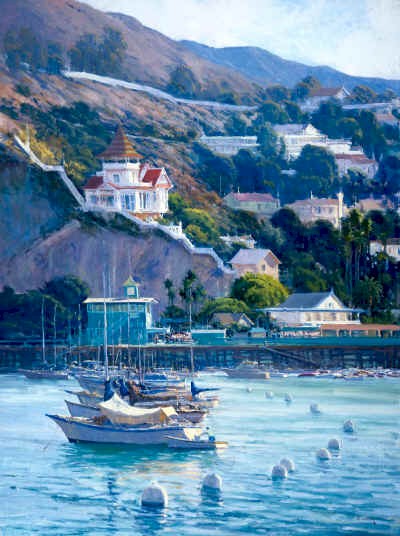 When
I want to paint, I head out the door to find a scene that will spark my
interest. This may take hours, or it may take minutes. What tends to
catch my eye is the light-- the pattern and contrast created on the subject, or
the warm glow of a late afternoon bathing a particular landscape. I'll
sometimes drive around, searching everywhere for the right spot, or it may be
right in front of me, waiting to be painted. Either way, I'll generally
spend some time getting acquainted with the scene, working out in my mind the
design and distinguishing light and dark patterns. When
I want to paint, I head out the door to find a scene that will spark my
interest. This may take hours, or it may take minutes. What tends to
catch my eye is the light-- the pattern and contrast created on the subject, or
the warm glow of a late afternoon bathing a particular landscape. I'll
sometimes drive around, searching everywhere for the right spot, or it may be
right in front of me, waiting to be painted. Either way, I'll generally
spend some time getting acquainted with the scene, working out in my mind the
design and distinguishing light and dark patterns.
I
ask myself, What's important here? What do I want to say about the
scene? Is it the warm light of a late afternoon, or am I drawn to a
particular effect, such as one ray of sunlight illuminating the valley on a
cloudy day? Perhaps it's a city scene full of life. Or are the
buildings the real story? Whatever it is that seems most important, that's
what I try to hold on to from start to finish.
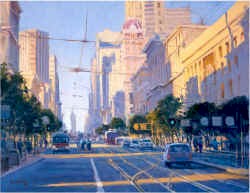 Whether it's a landscape or a cityscape, my first reaction is
to break it down into a simple statement. By paying close attention to
shapes and value, I start to paint a building in the same fashion as I paint a
tree or a mountain, by responding to the scene in flat and simple shapes.
(The only difference is that a street scene requires a bit more drawing at the
outset and more attention to perspective.) Then I'll go back and add
details and variation of color. I generally like to include some elements
of human life in my work when I can--a house, or maybe some animals or
people. I want to show the gentle sides of nature and man in a harmonious
existence. Whether it's a landscape or a cityscape, my first reaction is
to break it down into a simple statement. By paying close attention to
shapes and value, I start to paint a building in the same fashion as I paint a
tree or a mountain, by responding to the scene in flat and simple shapes.
(The only difference is that a street scene requires a bit more drawing at the
outset and more attention to perspective.) Then I'll go back and add
details and variation of color. I generally like to include some elements
of human life in my work when I can--a house, or maybe some animals or
people. I want to show the gentle sides of nature and man in a harmonious
existence.
|
